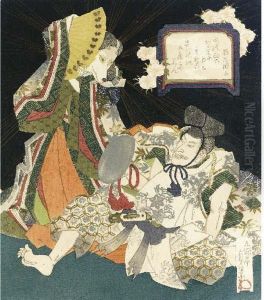Utagawa Sadakage Paintings
Utagawa Sadakage was a Japanese ukiyo-e artist known for his works in the first half of the 19th century. His exact birth and death dates remain unknown, but he was active between 1818 and 1844, a period that situates him in the late Edo period of Japanese history. Utagawa Sadakage was a part of the Utagawa school, which was one of the most influential schools in the history of Japanese woodblock printing. The school was founded by Utagawa Toyoharu during the late 18th century and saw its peak under the guidance of Utagawa Hiroshige and Utagawa Kuniyoshi, among others, during the 19th century. Sadakage's work can be characterized by its vibrant use of color, attention to detail, and dynamic composition, qualities that were emblematic of the Utagawa school's aesthetic.
Sadakage specialized in genres typical of the ukiyo-e tradition, including bijinga (pictures of beautiful women), yakusha-e (actor prints), and occasionally landscapes. His bijinga prints often depicted women in everyday activities, showcasing the beauty and fashion of the Edo period's Genroku culture. Meanwhile, his yakusha-e works captured the lively essence of kabuki theater actors, portraying them in dramatic poses and with expressive facial features. Although not as renowned as some of his contemporaries like Kuniyoshi or Kunisada, Sadakage's contributions to the ukiyo-e genre provided a valuable glimpse into the cultural and societal norms of his time.
The details of Sadakage's life are scarce, and much of what is known about him comes from the study of his works and the few historical records that mention him. It is believed that he was a student or follower of Gokotei Sadamasu, another artist in the Utagawa school, which might explain the similarities in their styles and the subjects they chose to depict. Despite his relative obscurity in comparison to other ukiyo-e masters, Sadakage's prints are appreciated by collectors and scholars for their artistic quality and historical value. His works are part of several collections worldwide, serving as a testament to the enduring appeal of the Utagawa school's artistry.
